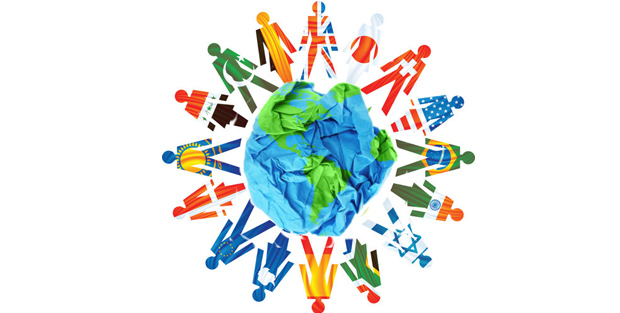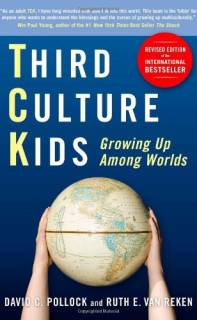What is the difference between a “third culture kid” and a“cross-cultural kid” ?
A third culture kid is a person who is growing up outside of their parent’s culture for a significant period of time during their core developmental years (the first 18) and interacts with different cultures. They grow up cross culturally with high mobility usually because of one or both parent’s career choice,
After my book Third Culture Kids with David Pollock came out, there were many people who said: “I identify with every page [of the book], but it happened to me differently.” The worlds of third culture kids and other growing up among many cultural worlds for a host of other reasons are far more complicated than we initially believed and unfortunately definitions became more of the focus as opposed to the reality of the experiences [that people were having]. I asked myself: “How can we get more conversations going between people of all these different groups who are having meaningful experiences across cultures?” “Cross-cultural kid” was more inclusive and representative of the variations of experiences. It also gives us opportunity to see the growing complexity of the traditional TCK experience as well. For example, many TCKs are already bi-cultural or mixed race in their families and I’ve met many who use one language at school by day and transform their language and cultural world each evening when they return home.
Should every family consider living abroad or sending their children abroad at some point during their core developmental years?
Of course, I think it’s a great idea for kids to learn about other cultures in a first hand way during these years. I did, my children did, my grandchildren are. But you have to know your child. Some kids may never be able to transplant for various reasons. For example, what if your child has a learning disability or special medical needs? S/he has to be in a place where s/he can be supported and given the best chance to succeed.
Understanding grief, growth, and gifts
Living abroad has so many wonderful advantages. Children get to see the world and realize first-hand how many interesting differences they are. But frequent relocations also have a cost. That doesn’t mean we shouldn’t make them but it means that parents must understand the dynamics of identity formation and transition for children so they can help their children navigate this experience in a way that gives them every opportunity to use the wonderful gifts they are also forming through a cross-cultural childhood.
We human beings find identity as it is mirrored back to us. When children are constantly changing cultural mirrors, however, the task is more complicated. How do they know which mirror is an accurate reflection of themselves? Therefore, parents should understand that cohesion of family is of the utmost importance because it is that stable identity that can travel with the family. Building portable family traditions is one way parents can help foster that sense of “this is us no matter where we are.” Third culture kids and other cross-cultural kids often have fabulously interesting lives, but some parts of it can be hard and living in a community where either they or those around them are constantly coming and going is one of those places. They are human beings. They need relationships like everyone else, but when they have to keep starting over, they cannot always build long-term relationships with people. This can impact their sense of belonging because someone has to know you in order for you to feel you belong.
Watch the conversation with Ruth Van Reken on Cultural Identity: Mosaic or Melting Pot at the LFNY, April 2014.
Because of that, parents, the organizations that send parents abroad and the schools that receive their children need to understand the normal transition cycle and work together to develop effective strategies to help children and families through the process. No matter how positive the next place will be, if your child has made friends and connections to the place where you are living, there will be some sense of loss as these attachments are broken. The grief they feel is actually an affirmation of the good they have known in this place. We aren’t sad to say goodbye to people or places we don’t care about! Remember that saying “goodbye” well is the key to also saying “hello” well on the other side. Sometimes kids can get lost in the grief they experience from coming and going and they need permission to process [the grief] amongst people who understand it. If professional help is needed, try to get a counselor who has some understanding of the dynamics of living an internationally mobile lifestyle.
If we teach children to deal with those challenges, then they can use the gifts they’ve received from their international experiences to really thrive in this globally interconnected society.
Being that students spend so much time at school, how can schools support and encourage cross-cultural kids?
Cultural diversity in school is more than just sampling food from other countries. It’s about hearing each other’s stories and learning why people think, feel, and act differently from one another. Writing assignments can be a great place where students share the many ways they may see the particular topic they were given to write on. Cultural clubs have a place in schools because our histories and backgrounds are important, yet they can be also be limiting for many cross-cultural kids if they are based only on traditional labels of of cultures, race, or nationality. For many who have grown up in multiple places and may have parents from different nationalities, races, or ethnicities, the choice on which club to belong to can sometimes create its own stress!. It’s not so easy to choose an affinity group when you’ve grown up amongst 9 different cultures or countries. Many schools have found that clubs based on common interests or shared types of experiences can also be helpful in nurturing their students to discover and gain confidence in their personal as well as cultural identity.
“It’s our experiences that are different, not our humanity.”
The cultural complexities for many children in today’s world are becoming enormous. The challenges to finding a clear sense of both personal and national identity are increasing. Yet knowing who I am and to whom I belong have been human quests through all time. In today’s world, perhaps we need permission to think about these things in new ways. The goal should be to help students embrace and establish their own personal identity and perhaps let them be creative to define their cultural identity in ways that match their often many layered cultural heritage.
Schools need to be mindful of what’s happening and realize they cannot assume who their students are or what their educational history has been either until they learn more of their story. There is so much wealth of experience to capitalize on and use in the classroom when they see the rich diversity beyond just physical appearance alone. It is exciting to see teachers who know how to tap into this new and widening breadth of global awareness that sits in front of them every day in their classrooms. Surely a new wave of potential global leadership is being developed when students are taught to recognize the gifts they are receiving of learning to respect other cultures and be cultural bridges as they daily negotiate the most interesting world around them in our schools themselves. Many are quite adaptable to change and often know how to code-switch! All of these can be a great asset for working in our globalizing world.
My mission is to help kids normalize their experiences and become confident in who they are. Our goal should be to help kids move through different spaces with different people and still be able to acknowledge who they are. They are not defined by their passport(s) alone. I want them to know it’s their experiences that are different, not their humanity One gift of a cross-cultural childhood is that often we have had opportunity to look at others first as human beings who shared similar emotions of joy, anger, love, or loneliness and want to be respected and affirmed just as we ourselves do. From that understanding, we can also continue exploring where, how, and why we may also see the world differently from each other and come to better understanding of one another than if we first start with the differences alone.
What can parents do to support their cross-cultural kids?
Talk about it! Keep an open dialogue! I didn’t realize that I was grieving until I started journaling at the age of 39. I had never acknowledged the grief that I had experienced as a child. When I was younger, there was no time, nor safe place to process the loss of the world I lost when I was 13 years old and left the land of my birth and upbringing for a permanent repatriation to the world others assumed was my “home.” As an adult, however, I allowed myself to go through the process of looking at the losses. I realized that, as I said above, the grief was an affirmation of my incredible experiences growing up in Nigeria and the land and place and people I would miss so much because I had loved them so deeply.
When I sent the journaling that become my first book, Letters Never Sent, to my mother, she responded in a wonderful way. She admitted that she wasn’t aware of what I went through and that she might have done things differently had she known. But she also said she was glad I told her and felt that I had done a good job at expressing myself without blaming my parents. She wasn’t at all defensive and gave me permission to keep exploring the topic. What a gift. Part of the process is to look at the story and when parents can give permission for dialog and discussion, no matter the age of the “child”, it is a wonderful, growing, experience for all. I wouldn’t trade my life for anyone else’s on the planet and I hope I can help other cross-cultural kids and their parents feel the same way about their own intriguing and intricate stories.
Photo: http://kazakhstanii.blogspot.com/2011/07/annotated-bilbliography-great-websites.html
About the Author :
Janelle Charles is Director of Admissions and Enrollment. She holds an MA in French Linguistics & Pedagogy from Middlebury College. She was a Teaching Fellow in NYC public schools and was previously a French and Spanish teacher at Greenwich Country Day, then Assistant Director of Admissions. She joined the Lycée in 2021.



2 comments
Comments are closed.